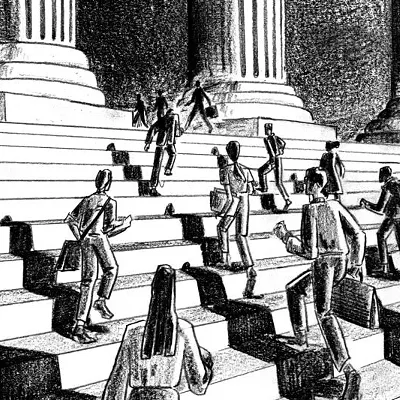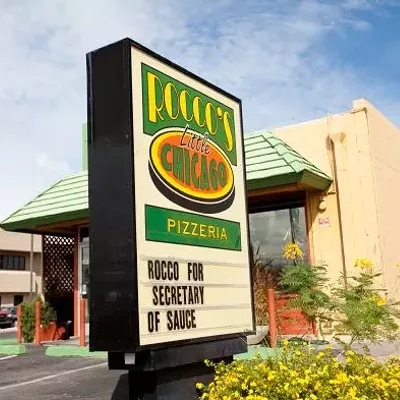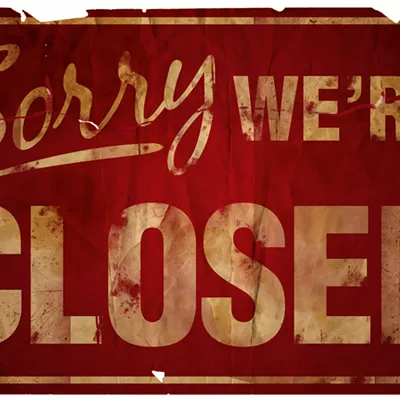But many professionals who deal with poverty locally insist the federal guidelines are far too low. They believe that if a realistic monetary amount were used, the city of Tucson would have more than one in every four persons classified as poor.
While the percentage of the population living on less than the poverty standard dipped somewhat during the economic good times of the 1990s, indications are now that with the slow economy those numbers may have jumped to record high figures. Several social service providers agree that is exactly what is happening.
Brian Flagg of the Casa Maria soup kitchen says of the demand for their meals, "Its more intense than it has ever been. We've never had more single people than now, even though a huge percentage of those at Casa Maria are out there working, like guys at labor halls."
The head of Tucson's Urban League office, Ray Clarke, was surprised there had even been a decline in poverty in Tucson during the '90s. "I didn't think it would drop," he says, "because the requests for our services has increased."
Current high demand for job opportunities also points to a growing number of poor people, according to Don Strauch of Tucson Metropolitan Ministries. "About three years ago it looked like the situation might take care of itself. We had difficulty in filling some positions. But recently we had 30 applicants for a job whereas a few years ago we would have had four."
Tucson's poverty figures are also embarrassingly high when compared to most other mid- and large Southwestern cities, but at least the gap narrowed slightly in the last decade. Despite that, when it comes to percentage of people living in poverty, our community fell behind in the 1980s and has not caught up since.A major problem directly related to poverty rates is the traditionally low wages which are paid locally. With people working for less money per hour, it can be expected that a higher percentage of them will be poor. Thus, the trend in Tucson toward more and more working people living in poverty continues to grow.
Marshall Vest, director of the University of Arizona's economic and business research program, points out some positives, however. Over the last six years, the annual rate of earnings in the metropolitan area rose 3.8 percent, well above yearly inflation of 2.3 percent. "That was a good gain," he says, but also adds that annual pay here is only 90 percent of the state level, and 83 percent of the national figure.
Despite somewhat higher wages than in the past, local social service providers have seen that good news disappear in the last two years. As the economy slowed and job layoffs mounted, more people than ever appeared to be poor.
Punch Woods, who recently stepped down as director of Tucson's Food Bank, summarizes the situation. Believing the federal poverty guidelines are too low, he says, "It's more than one in four households that are really having trouble and are stuck in poverty. We're providing more food boxes than ever before. There's really been a quantum leap. We're losing ground. It's worse today than it was 25 years ago both in total numbers and as a proportion of the entire population."
Father Raul Trevizo, pastor of the southside St. John's Catholic Church, adds another perspective. "We were told there was an economic boom in the '90s," he says, "but poor people are last to get on the boom but the first ones to feel the effects in a downturn. They benefited very little from the boom, but are feeling the effects [of the downturn] now, and it is only getting worse."
What can be done to decrease the high level of local poverty? Six years ago, a cross-section of community leaders was asked that question by The Weekly, and recently they were contacted again.
Back in 1996, Bob Walkup, then-president of the Greater Tucson Economic Council, said he thought the economic corner had been turned. Now as mayor, Walkup offers the opinion, "A lot has happened in the last six years to help. There have been a lot of positive things with only a couple of downers, and even they're turning around." Tucson can attract quality jobs which pay livable wages, Walkup believes, but says we need more trained people to fill those positions.
To help accomplish that, Walkup's wife Beth has been serving on the board of directors of Jobs Partnership. It is a year-old group which combines businesses and faith-based organizations to identify underemployed people and get them trained and into jobs.
"I'm very optimistic about the future, about job creation," the mayor says. "I'm very hopeful."
A different view is taken by members of the Pima County Interfaith Council. In 1997 the late Jim Haag of PCIC said of Tucson's ongoing efforts to grow its way out poverty, "To keep doing the same things and expecting different results is a definition of insanity." Now members of the group believe the situation is getting worse, but agree that job training programs are one part of any possible solution.
PCIC has its own training program, JOBPATH, which in the past four years has helped 253 people graduate to better paying jobs. The program's funding, however, was severely cut by the city in July, a reduction supported by Walkup, and now applicants for health care training assistance are being turned away.
Bob Jensen, outgoing chancellor of Pima Community College, supports more government money for education and job training as a method to fight poverty. "There is a correlation between educational achievement and the poverty rate," Jensen says.
But given the difficult budgetary situation at all levels of government, is it reasonable to expect increases in funding for those programs? "The economic things will swing back," Jensen says, "so now is the time to talk about public policy. What will Arizona do to have an economy that provides jobs with benefits? It's not a pretty picture right now with our youth. But we have to address the issue now. It's great to have sunshine, but if people and infrastructure [are in trouble,] that doesn't make any difference."
Karin Uhlich of the Southwest Center for Economic Integrity thinks use of the tax breaks provided by Tucson's federally designated enterprise zone are critical. "We have to leverage the zone to benefit the working poor and newly unemployed," she says, "while insuring there is aggressive outreach [for the program] and reinvestment in the area. We just can't go through the motions like any other city."
Both the Food Bank's Woods and Clarke at the Urban League mention another possible method to fight poverty: legislatively mandated higher wages. "The Food Bank isn't the answer," Woods says emphatically. "Livable wages, employment, housing and health care are. We can't afford this kind of poverty in our community, or in the nation."
Clarke agrees that living wages are important, saying, "Ten years ago I had greater hope than now. That time represented a great opportunity, but we're not where we should be. There are lots of reasons for that, including we're still debating the issues and not coming to any resolution."
But Woods acknowledges that the term livable wage, "are fighting words for some." Walkup says of the idea, "We all have a desire for livable wages. Some want to do that legislatively, but I think in the longer range the reasonable thing is to make sure jobs are available [which pay livable wages] and insure people can compete for them through quality training programs."
From his perspective, however, Father Trevizo believes, "It's not as simplistic as saying, 'We're bringing in a couple of hundred better paying jobs' as a solution."
So what else can be done? The University of Arizona's Marshall Vest holds out the hope that the local economy could be improving. While the last few years have seen actual job losses in all but two economic sectors, he thinks by the middle of 2003 each of them should be growing again. "We haven't recovered from the recession yet," he says, "but when we get through this period, the economy will look better."
The members of the Pima County Interfaith Council have their own idea to decrease poverty in Tucson. If successful, it could send shudders through politicians.
PCIC has targeted the poor and their voting habits. Pointing out that typical turnout in impoverished areas during primary elections was 7 to 10 percent, Trevizo says the Catholic Church has implemented a "Faithful Citizenship" program to encourage people to vote.
This effort, he believes, was one reason why in September's primary the turnout in these same areas averaged 30 percent. "We hope the higher turnout will encourage people to be heard."
Brian Flagg puts that goal in blunter terms. "Hopefully people will get off their rear ends and vote. That can change the current policy which is anti-poor people. We can reverse that trend based on turnout. [These people] wouldn't be taken for granted any longer [if they vote]. That is the key to power."










